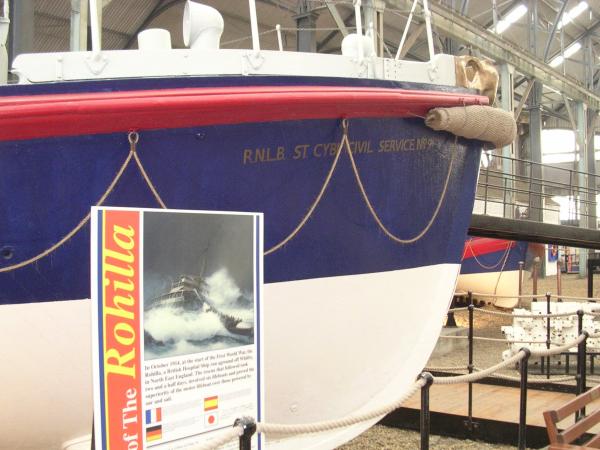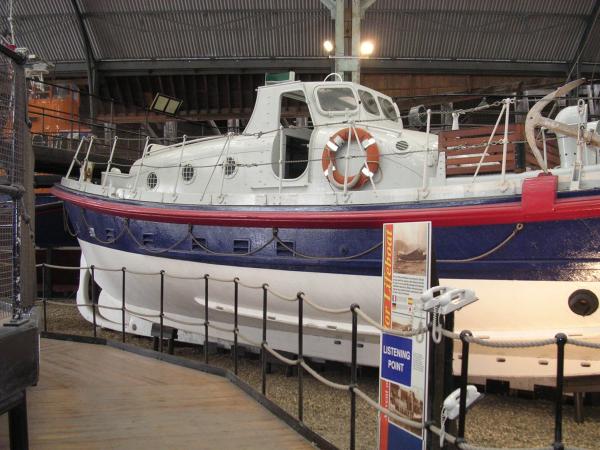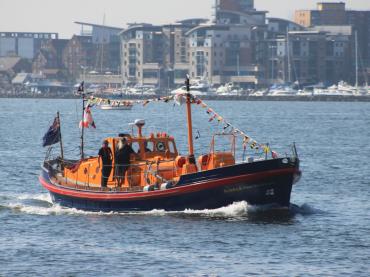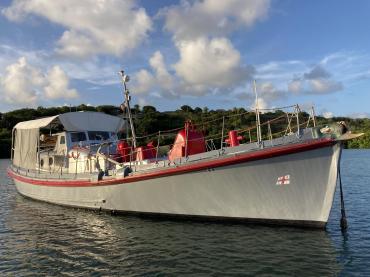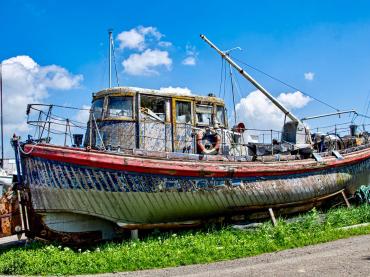


Details
Construction
Dimensions
History
ST. CYBI (CS No 9) is a Barnett twin screw motor boat. Her yard number was W5419 and her lifeboat number was 884. On 2nd December 1966. She is credited with 262 service launches and 167 lives saved.
ST CYBI rescued five of the crew of a Greek motor vessel NAFSIPOROS which was in distress four hundred yards west of the West Mouse Rock in a north-westerly hurricane with a very rough sea. For this service Lieutenant Commander H H Harvey VRD RNR, Inspector of lifeboats for the North West Area, was awarded the RNLI Gold Medal, and coxswain Thomas Alcock and Motor Mechanic E S Jones were awarded the Silver Medal. Bronze Medals were awarded as follows: Second Coxswain W J Jones, Acting Bowman F Ward, Acting Assistant Mechanic J Sharpe, Crew Member J Hughes, Crew Member D Drinkwater, Crew Member B Steward. ST CYBI was sold out of service in 1986 and is now on display as a museum vessel at the Historic Dockyard, Chatham.
Significance
- What is the vessel’s ability to demonstrate history in her physical fabric?
Evidence for designs, functions, techniques, processes, styles, customs and habits or uses and associations in relation to events and people. How early, intact or rare these features are may impact on significance.
ST CYBI is a 52-foot twin screw lifeboat with double diagonal planking on bent timber frames. Designed by James Barnett, she is wooden decked, with an aluminium superstructure. She is divided into 9 watertight compartments, which are fitted with 257 air cases. All 52ft Barnetts were fitted with airbags in the 1970s to give a self-righting capability. She was placed on display directly from service, so her hull is unchanged from that time although it has subsequently been grit-blasted with some paint damage. Her RNLI fittings remain intact, demonstrating her function, and minor alterations only have been made for interpretation purposes, such as the replacement of the air box cover with Perspex. One of the samson posts on the stern has also had a section cut out of it to facilitate the visitor walkway. The rear cabin retains most of its radar equipment and the holes for the airbag in the roof survive, although these have been plugged and the air bag itself is no longer in place. The echo sounder remains onboard. The forward chamber flotation tanks have been removed to storage. The vessel offers a good example of typical in-service modifications, with later engines having been installed which are still in place, along with all ancillary equipment. The forward cabin retains its original panelling, light fittings and deck lights. The engine room inspection covers on deck are fitted with stainless bolts and there is an inspection hatch. Some sections of her forward planking have been replaced, using steel bolts in place of the original countersunk bronze ones.
- What are the vessel’s associational links for which there is no physical evidence?
Associations with people or places. Off-ship research.
ST CYBI was built in 1950 by J S White of Cowes and paid for by the Civil Service lifeboat fund. She has regional connections to Holyhead where she was in service for thirty years before moving to the relief fleet. In 1966, she famously rescued five crew members from a Greek motor vessel which was in distress in a north-westerly hurricane with a very rough sea. As a result of this rescue, a double RNLI gold medal was awarded, plus two silver medals and six bronze medals. A further three bronze medals were awarded in 1971. In total, between 1950 and 1985, ST CYBI is credited with saving 167 lives over 262 service launches. She was recorded on the National Register of Historic Vessels in 1999.
- How does the vessel’s shape or form combine and contribute to her function?
Overall aesthetic impact of the vessel, her lines, material she was built from and her setting. Does she remain in her working environment?
As a 52-foot Barnett class lifeboat, ST CYBI has the distinctive deck feature of an enclosed midship steering position, with perspex windows to provide visibility. Her deck cabin provides shelter for rescuers and rescued. The crew could also get to the after cockpit through the cabin without having to go on deck. As the external doors were not watertight, scuppers were fitted at cabin-floor level so that water entering the cabin or wheelhouse flowed under the lockers and overboard. Her engine room was a watertight compartment and she was powered by a pair of twin engines. Emergency steering could be rigged from the after cockpit and the door also provided stretcher access. Besides a crew of eight, the 52ft Barnett could carry 100 people in rough weather. ST CYBI is currently exhibited out of the water at the Historic Dockyard, Chatham, representing her type as part of the largest collection of RNLI historic lifeboats on display in the UK.
Source: NHS-UK team, April 2024.
Own this vessel?
If you are the owner of this vessel and would like to provide more details or updated information, please contact info@nationalhistoricships.org.uk


